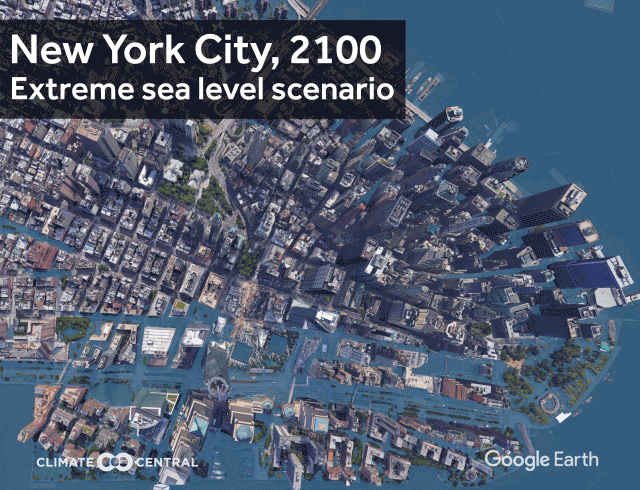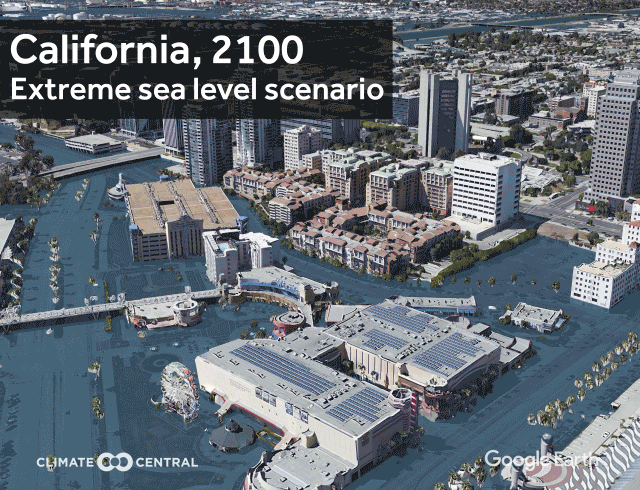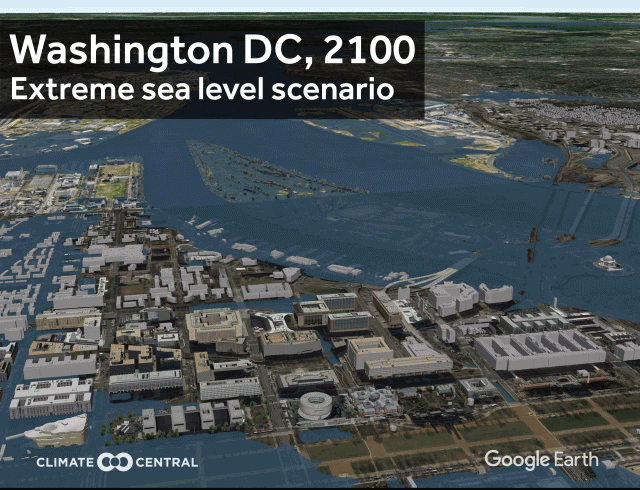

SUBSCRIBE TO OUR FREE NEWSLETTER
Daily news & progressive opinion—funded by the people, not the corporations—delivered straight to your inbox.
5
#000000
#FFFFFF
To donate by check, phone, or other method, see our More Ways to Give page.


Daily news & progressive opinion—funded by the people, not the corporations—delivered straight to your inbox.
A new report shows that many previous estimates of global sea level rise by 2100 were far too conservative, the Washington Post reported Thursday, and the research comes as new maps and graphics from Climate Central vividly show how disastrous that flooding will be for U.S. cities.
The report, Snow, Water, Ice and Permafrost in the Arctic, found that previous estimates of sea level rise didn't account enough for the fast pace of melting ice in the Arctic and Greenland.
The Post writes:
The assessment found that under a relatively moderate global warming scenario--one that slightly exceeds the temperature targets contained in the Paris climate agreement--seas could be expected to rise "at least" 52 centimeters, or 1.7 feet, by the year 2100. Under a more extreme, "business as usual" warming scenario, meanwhile, the minimum rise would be 74 centimeters, or 2.4 feet.
The report explored a minimum rise scenario, but not a maximum or worst-case scenario. However, a separate report (pdf) published at the end of the Obama administration by the National Oceanic and Atmospheric Administration (NOAA) did just that, and found that in the most extreme case, the sea in some locations will rise a stunning eight feet by the century's end.
Illustrating how devastating this would be, Climate Central created 3D visualizations of what U.S. cities will look like in NOAA's most extreme scenario.
Some cities, such as New Orleans, would simply be uninhabitable, the images show:




Rising seas alone may displace over 13 million people in the U.S., dispersing climate refugees and reshaping inland cities, as Common Dreams reported last week.
See more examples of Climate Central's visualizations here and here, and find a 2D map of sea level rise projections here.
The ominous new research come as President Donald Trump continues to dismantle climate policies, boosts the fossil fuel industry, and considers pulling out of the Paris climate accord.
But even Trump won't be spared from the looming disaster, Climate Central observes, showing that the projected sea level rise will completely flood the president's Mar-a-Lago resort.
Dear Common Dreams reader, The U.S. is on a fast track to authoritarianism like nothing I've ever seen. Meanwhile, corporate news outlets are utterly capitulating to Trump, twisting their coverage to avoid drawing his ire while lining up to stuff cash in his pockets. That's why I believe that Common Dreams is doing the best and most consequential reporting that we've ever done. Our small but mighty team is a progressive reporting powerhouse, covering the news every day that the corporate media never will. Our mission has always been simple: To inform. To inspire. And to ignite change for the common good. Now here's the key piece that I want all our readers to understand: None of this would be possible without your financial support. That's not just some fundraising cliche. It's the absolute and literal truth. We don't accept corporate advertising and never will. We don't have a paywall because we don't think people should be blocked from critical news based on their ability to pay. Everything we do is funded by the donations of readers like you. Will you donate now to help power the nonprofit, independent reporting of Common Dreams? Thank you for being a vital member of our community. Together, we can keep independent journalism alive when it’s needed most. - Craig Brown, Co-founder |
A new report shows that many previous estimates of global sea level rise by 2100 were far too conservative, the Washington Post reported Thursday, and the research comes as new maps and graphics from Climate Central vividly show how disastrous that flooding will be for U.S. cities.
The report, Snow, Water, Ice and Permafrost in the Arctic, found that previous estimates of sea level rise didn't account enough for the fast pace of melting ice in the Arctic and Greenland.
The Post writes:
The assessment found that under a relatively moderate global warming scenario--one that slightly exceeds the temperature targets contained in the Paris climate agreement--seas could be expected to rise "at least" 52 centimeters, or 1.7 feet, by the year 2100. Under a more extreme, "business as usual" warming scenario, meanwhile, the minimum rise would be 74 centimeters, or 2.4 feet.
The report explored a minimum rise scenario, but not a maximum or worst-case scenario. However, a separate report (pdf) published at the end of the Obama administration by the National Oceanic and Atmospheric Administration (NOAA) did just that, and found that in the most extreme case, the sea in some locations will rise a stunning eight feet by the century's end.
Illustrating how devastating this would be, Climate Central created 3D visualizations of what U.S. cities will look like in NOAA's most extreme scenario.
Some cities, such as New Orleans, would simply be uninhabitable, the images show:




Rising seas alone may displace over 13 million people in the U.S., dispersing climate refugees and reshaping inland cities, as Common Dreams reported last week.
See more examples of Climate Central's visualizations here and here, and find a 2D map of sea level rise projections here.
The ominous new research come as President Donald Trump continues to dismantle climate policies, boosts the fossil fuel industry, and considers pulling out of the Paris climate accord.
But even Trump won't be spared from the looming disaster, Climate Central observes, showing that the projected sea level rise will completely flood the president's Mar-a-Lago resort.
A new report shows that many previous estimates of global sea level rise by 2100 were far too conservative, the Washington Post reported Thursday, and the research comes as new maps and graphics from Climate Central vividly show how disastrous that flooding will be for U.S. cities.
The report, Snow, Water, Ice and Permafrost in the Arctic, found that previous estimates of sea level rise didn't account enough for the fast pace of melting ice in the Arctic and Greenland.
The Post writes:
The assessment found that under a relatively moderate global warming scenario--one that slightly exceeds the temperature targets contained in the Paris climate agreement--seas could be expected to rise "at least" 52 centimeters, or 1.7 feet, by the year 2100. Under a more extreme, "business as usual" warming scenario, meanwhile, the minimum rise would be 74 centimeters, or 2.4 feet.
The report explored a minimum rise scenario, but not a maximum or worst-case scenario. However, a separate report (pdf) published at the end of the Obama administration by the National Oceanic and Atmospheric Administration (NOAA) did just that, and found that in the most extreme case, the sea in some locations will rise a stunning eight feet by the century's end.
Illustrating how devastating this would be, Climate Central created 3D visualizations of what U.S. cities will look like in NOAA's most extreme scenario.
Some cities, such as New Orleans, would simply be uninhabitable, the images show:




Rising seas alone may displace over 13 million people in the U.S., dispersing climate refugees and reshaping inland cities, as Common Dreams reported last week.
See more examples of Climate Central's visualizations here and here, and find a 2D map of sea level rise projections here.
The ominous new research come as President Donald Trump continues to dismantle climate policies, boosts the fossil fuel industry, and considers pulling out of the Paris climate accord.
But even Trump won't be spared from the looming disaster, Climate Central observes, showing that the projected sea level rise will completely flood the president's Mar-a-Lago resort.